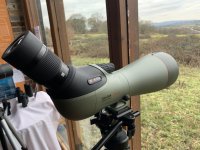I believe I have the same ball head as yours without the friction adjustment knob and is rated 11kg max load. My 60mm scope weighs about 1.6kg, but is smaller in size than the razor 85mm. Been using the scope mounted sideways on the gitzo ball head nearly a year and half, holds up well. Strangely, the 1545T was not recommended when I tested it in my local store and the store attendant (also a bird photographer) is willing to sell me his, if I was interested.
To be safe, you could try side mount configuration for a short duration ~20mins to have a feel of how a gimbal operates and switch back to the normal mode.
Issues when side mounted:
1) Centre of mass of the scope is no longer in line with the central column which probably will cause jerky panning with lower quality ball. Not immediately noticeable, but very obvious when you try to do fine panning when scope is at rest. My Sirui ball heads from small to large, all had this issue. No issue with my current small gitzo ball head-once you overcome the scope's inertia, it rotates smoothly. Of course your tripod have to be more or less level.
2) Tilt is not as smooth as a proper gimbal due to friction in the notch at the side, but the advantage is that the scope more readily stays pointed to your stationary target, and you can immediately hands off the scope to use your binos when you are alerted to some other bird/animal.
3) This is not an issue if your tripod have screws to tighten the head you use or maybe you mount scope to the right of the ball head. The traveller series 1 and 2 tripod does not have tightening screws for the head. If you mount your scope sideways to the left, the head will tend to unscrew itself due to the turning moment of the scope being off axis from the central column when you carry it over your shoulder. I mount it left side because I prefer the positions of the pan and ball locking knobs, and the upright position of the rotating collar knob on the scope. Had to use purple loctite on both ends of the stainless steel screw connecting the ball head and the center column (probably a no-no).
4) Lose a few centimeters of useable height.
5) Require a camera plate of suitable length to balance the scope horizontally.
6) Use of a video/anti rotation pin if your scope leg is only single screw. I also purple loctite the plate screw to the scope leg for the added security.
This configuration is obviously not for everyone, just my personal preference with a small sized scope (but heavy) to keep the mounting head compact and light. Using a good fluid head without a handle, as Hermann shared, is a viable alternative, but I currently prefer the simplicity of a ball head without the size and weight of a proper gimbal or with the Wimberley sidekick.
I've only look through an ATS 65mm at an owl across a body of water once before I got the monarch so I can't compare to the premium brands. Not financially well-off to spend that much too, hence a reluctance to try out fellow bird watcher's swarovskis to avoid "optics infection".
The 82mm monarch probably isn't too overweight compared to a 80 or 85mm scope due to the excellent oversized prism, but the 60mm probably is overweight at ~1.25kg for the scope body only and is back heavy. Nick90's and henry link's reviews of the 60 and 82 monarch led to my purchase of the monarch 60mm. If a zoom eyepiece is preferred, skip the 20-60x eyepiece and get the 30-60W wide angle zoom if possible. A fixed 38W 75° AFOV wide angle eyepiece with long eye relief is also available. Views are pleasant even at my 48x limit, CA is there as you look towards the edge but non intrusive and since no roof edge along optical path, no prism line visible. Occasional night sky viewing does not show any discernable optical defects with the 30-60W and 38W eyepieces, though the 20-60 showed sagittal(?) astigmatism at the lower magnification range. 16.1-15.3mm ER of the 20-60 eyepiece is not good for spectacle wearers (especially the intermediate magnification range) but the seemingly short 15.2-14.2mm ER of the 30-60W eyepiece is actually useable and better than the 20-60. Rubber armor is only present at the prism section and I prefer the minimal use of it, others might not. The scope body is solid and very well made, though I suspect there are some bubbles in the glass due to consistent round blobs which can be seen on defocused stars when doing star tests. Internal reflections seems well controlled since it is black around the exit pupil, but lens glare is there when pointing near the sun. Also, reflections due to bright sky behind/above off the eyepieces is a bit annoying, but can be mitigated by wearing a sunhat.
The relatively small sized monarch 60mm performs well and fits my type of casual usage in nature parks, reserves, coastal sightseeing and the occasional night sky watching, despite the listed short comings. Does the performance of the oversized prism justify the extra weight? I don't know. Frankly, I don't really care much now. I treat it as a workout and use it till it falls apart.
As a side note, there is this video comparison between the votex razor hd 27-60 and the monarch 82 30-60W on youtube, but your first discussion about the razor discounted the monarch, thus I did not comment there. ICYMI (you can auto translate to english):










